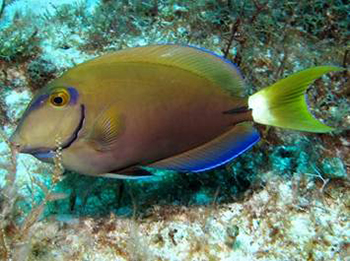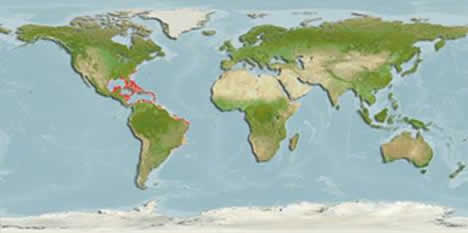Ocean Surgeonfish
Acanthurus bahianus

Kingdom: Animalia
Phylum: Chordata
Class: Actinopterygii
Order: Perciformes
Family: Acanthuridae
Genus: Acanthurus
Species: A. bahianus
Description:
This fish is typically six to twelve inches in length and can reach a maximum of fifteen inches. Their oval-shaped body has uniform coloration that can vary from bluish gray to much darker. The pectoral fin often has a yellowish tint. This species can also change color rapidly which is a very neat feature.
Habitat, Feeding, and Behavior:
The ocean surgeonfish is a common species found in the Caribbean, the Bahamas, Florida, the Gulf of Mexico, Bermuda, and along the Atlantic coast as far up as Massachusetts down to Brazil. It lives in benthic locations on shallow reefs at a depth of up to 80 feet. The surgeonfish is typically found in groups with blue tangs and doctorfish and is active during the day. This species is a diurnal herbivore that feeds on filamentous and fleshy algae in groups of five or more. This fish is not shy but may become cautious when divers are present.

Reproduction:
Spawning occurs in the water column in pairs or large groups containing up to 20,000 individuals. The tiny eggs hatch in about 28 hours after deposition. Larvae start out in the pelagic stage then settle on coral patches in shallow water or sea grass where they metamorphose into juveniles. It takes around two years for the fish to become sexually mature and they may live up to ten years.
Conservation Status and Human Uses:
The Ocean Surgeonfish is not currently a species at risk. Typical human uses for this fish are mainly for stocking personal aquaria, but also include fisheries and the occasional use as bait.
Recent Research:
Current research studies the benefits of the schooling behavior of the Ocean Surgeonfish. It is noted that Con- and heterospecific schooling may allow individuals to spend more time foraging and less time being viligant due to improved predator detection . If so, the feeding rate of individuals in groups would be higher than that of solitary foragers. Alternatively, schooling could increase competition among individuals, leading to decreased feeding rate, which would favor solitary foraging. Competition may also be higher among conspecifics than among heterospecifics, leading to a lower feeding rate of individuals in conspecific groups than those in heterospecific groups. Data indicated that the feeding rate of adults was unaffected by schooling behavior. Juveniles showed higher feeding rates while in heterospecific groups. Foraging time was notably increased when the fish schooled in mixed species groups as a result of increased predator detection, possibly due to a decrease in same-species competition.
Suggested Link:
http://www.fishbase.org/summary/942
References:
Please note that the following references may have either been removed or relocated by the webpage owners since the time this student report was created.
Mark McGinley (Lead Author);C Michael Hogan (Topic Editor) "Ocean surgeonfish". In: Encyclopedia of Earth. Eds. Cutler J. Cleveland (Washington, D.C.: Environmental Information Coalition, National Council for Science and the Environment). [First published in the Encyclopedia of Earth October 22, 2009; Last revised Date December 6, 2011]; Retrieved May 30, 2013 http://www.eoearth.org/article/Ocean_surgeonfish?topic=49540
ReefNet. “Reef Fish Identification: Florida, Caribbean, Bahamas” Interactive – 4th Ed. New World Publications (2007).
Peart, David (lead researcher and reporter). “Research: With A Little Help from My Friends: Benefits of Schooling in Ocean Surgeonfish”. In: Dartmouth Undergraduate Journal of Science (2008). Retrieved May 30, 2013. http://dujs.dartmouth.edu/fall-2008/research-with-a-little-help-from-my-friends-benefits-of-schooling-in-ocean-surgeonfish#.UagObpywXDU